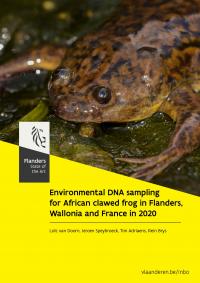Gedaan met laden. U bevindt zich op: Environmental DNA sampling for African clawed frog in Flanders, Wallonia and France in 2020
Environmental DNA sampling for African clawed frog in Flanders, Wallonia and France in 2020
The African clawed frog Xenopus laevis, native to Sub-Saharan Africa, was introduced to natural systems around the globe. Introductions originate from escapes or releases linked to the pet trade and from laboratories that use animals as model organisms in develop-mental and cellular biology (Measey et al. 2012). There are several physiological and demographic traits that can explain the success of the species as an invasive species. Xenopus laevis has a largely aquatic ecology, can adapt to a wide range of (anthropogenic) habitats, tolerate temperature fluctuations, salinity and pollution. It is able to burrow itself in the substrate, thereby persisting unfavourable conditions such as drought periods (Sousa et al. 2018). Apart from aquatic migration, the species is able to disperse over land (Measey 2016). Furthermore, this species has large clutch sizes (up to 17.000 ova/female) and can reproduce several times per year and can attain an age of at least 15 years.

Lees de publicatie
- Publicatiedatum
- Februari 2022
- Publicatietype
- Onderzoeksrapport
- Thema's
- Natuur en bos
- Auteur(s)
- Loïc van Doorn, Jeroen Speybroeck, Tim Adriaens, Rein Brys
- Reeks
- Rapporten van het Instituut voor Natuur- en Bosonderzoek 2022 (6)